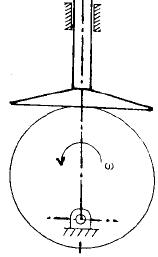Test: CAM & Balancing of Rigid Rotors & Field Balancing - 2 - Mechanical Engineering MCQ
25 Questions MCQ Test - Test: CAM & Balancing of Rigid Rotors & Field Balancing - 2
The above figure shows a cam with a circular profile, rotating with a uniform angular velocity of ω rad/s.
What is the nature of displacement of the follower?

What is the nature of displacement of the follower?
If a two-mass system is dynamically equivalent to a rigid body, then the system will NOT satisfy the condition that the
Which one of the following sets of elements are quick acting clamping elements for fixtures?
A statically-balanced system is shown in the given Figure. Two equal weights W, each with an eccentricity e, are placed on opposite sides of the axis in the same axial plane. The axial distance between them is 'a'. The total dynamic reactions at the supports will be
The choice of displacement diagram during rise or return of a follower of a cam-follower mechanism is based on dynamic considerations. For high speed cam follower mechanism, the most suitable displacement for the follower is
A rotor supported at A and B, carries two masses as shown in the given figure. The rotor is
In a cam drive, it is essential to off-set the axis of a follower to
What is the number of nodes in a shaft carrying three rotors?
In a cam drive with uniform velocity follower, the slope of the displacement must be as shown in Fig. I. But in actual practice it is as shown in Fig. II (i.e. rounded at the corners).
This is because of
Which one of the following can completely balance several masses revolving in different planes on a shaft?
Assertion (A): Cam of a specified contour is preferred to a cam with a specified follower motion.
Reason (R): Cam of a specified contour has superior performance.
Masses B1, B2 and 9 kg are attached to a shaft in parallel planes as shown in the figure. If the shaft is rotating at 100 rpm, the mass B2 is
Which one of the following is an Open Pair?
Static balancing is satisfactory for low speed rotors but with increasing speeds, dynamic balancing becomes necessary. This is because, the
For a given lift of the follower in a given angular motion of the cam, the acceleration/retardation of the follower will be the least when the profile of the cam during the rise portion is
The figures given on right show different schemes suggested to transmit continuous rotary motion from axis A to axis B. Which of these schemes are not dynamically balanced?
Consider the following follower motions in respect of a given lift, speed of rotation and angle of stroke of a cam:
1. Cycloidal motion.
2. Simple harmonic motion.
3. Uniform velocity motion.
Which one of the following is the correct sequence of the above in the descending order of maximum velocity?
Consider the following necessary and sufficient conditions for replacing a rigid body by a dynamical equivalent system of two masses:
1. Total mass must be equal to that of the rigid body.
2. Sum of the squares of radii of gyration of two masses about the c.g. of the rigid body must be equal to square of its radius of gyration about the same point.
3. The c.g. of two masses must coincide with that of the rigid body.
4. The total moment of inertia of two masses about an axis through the c.g. must be equal to that of the rigid body.
Which of the above conditions are correct?
What is the maximum acceleration of a cam follower undergoing simple harmonic motion?
Where, h = Stroke of the follower; (ω) = Angular velocity of the cam; ɸ = Cam rotation angle for the maximum follower displacemen
Which of the following conditions are to be satisfied by a two-mass system which is dynamically equivalent to a rigid body?
1. The total mass should be equal to that of the rigid body.
2. The centre of gravity should coincide with that of the rigid body.
3. The total moment of inertia about an axis through the centre of gravity must be equal to that of the rigid body.
Select the correct answer using the codes given below:
Consider the following statements:
1. For a radial-translating roller follower, parabolic motion of the follower is very suitable for high speed cams.
2. Pitch point on pitch circle of a cam corresponds to the point of maximum pressure angle.
Which of the statements given above is/are correct?
A rigid rotor consists of a system of two masses located as shown in the given figure. The system is
The shaft-rotor system given above is
For the rotor system shown in figure, the mass required for its complete balancing is
Two rotors are mounted on a shaft. If the unbalanced force due to one rotor is equal in magnitude to the unbalanced force due to the other rotor, but positioned exactly 1800 apart, then the system will be balanced














